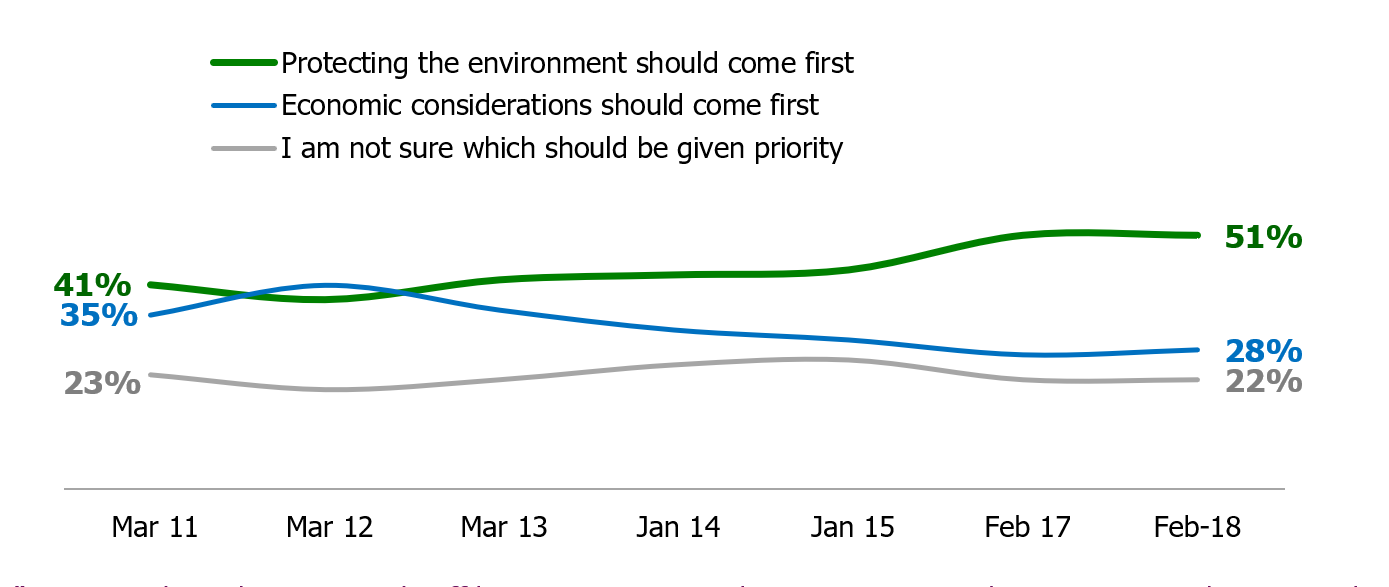The world as we know it is under increasing threat. Excess waste polluting our oceans, more species at threat of extinction, temperatures rising at record rates in the Arctic and the United States potentially withdrawing from the Paris Accord.
Given all of this it is easy to feel dejected about the current situation of our only planet. However, the picture isn’t entirely grim. As more and more headlines are generated regarding the fate of the Earth the public are starting to register their concern in large numbers.
The recent data from nfpSynergy’s Charity Awareness Monitor has shown that half of the British public now believe that the protection of the environment should be prioritised ahead of economic considerations, while 6 years ago economic considerations were held to be of greater importance.

 “In cases where there is a trade-off between protecting the environment and economic considerations, which do you think should be given the highest priority?”
“In cases where there is a trade-off between protecting the environment and economic considerations, which do you think should be given the highest priority?”
Source: Charity Awareness Monitor, Feb 18, nfpSynergy | Base: 1,000 adults 16+, Britain
Whilst this is encouraging, the public nonetheless continue to show a serious lack of awareness as to which charities are working within the environment sector.
For instance, in the area of climate change, three quarters of the public (75%) could not name a charity working specifically within this area[1]. An even greater figure (77%) could not think of any organisation that worked in the area of Marine conservation and over half (54%) could not name a single charity working in the field of protecting the environment[2].
Put simply, the national (and global) concern for our planet has not translated into a greater awareness of individual charities working within the environmental and conservation sectors. These charities continue to be, at best, in the background when it comes to the wider debate surrounding our natural world.
So how do environmental and conservation charities make themselves more visible and identifiable to the public?
As ever, digital engagement represents an ideal opportunity for environmental charities to make themselves more recognisable. But they still have a lot to catch up on, as the last year’s House of Lords Select Committee report indicated.[3]
Yet, some environmental non-profits are already pioneering in this field.
Take an inspiration from WWF Singapore. In the centre of their current campaign to raise awareness of the country’s controversial wildlife laws is the fictitious ‘Ivory Lane’ brand online shop, purporting to sell ‘luxurious’ ivory accessories within the Singaporean market. While some felt WWF’s campaign exploited the fake news culture that has engulfed social media in recent times, the stunt was incredibly successful, generating debate and discussion across social media as well as gaining widespread media coverage across the globe and bringing Singapore’s controversial ivory laws to the fore.[4]
Virtual reality (VR) is another digital tool that has been seen as increasingly accessible and affordable for organisations across the world to engage their audiences. And the third sector is waking up to this potential too.
Within the environment sector specifically, this summer saw Greenpeace run a free event in Cambridge allowing members of the public to fully immerse themselves within the Antarctic and its great wilderness. For charities working in environment and conservation, a sector that relies heavily on the imagery of nature and wildlife, VR is the perfect tool by which these organisations can fully engage those who are sympathetic and concerned of the environmental threats posed upon us.
As ever, it will require foresight and proactivity for these organisations to fully maximise the benefits that such innovations provide. But with the rising public concern for environmental and conservation issues, there is no better time for these charities to increase their visibility in the public eye and with it continue to act positively and decisively for the best interests of our natural world.
--
If you want to know more about what the public think of your brand and how you compare to your charity peers, subscribe to our quarterly Charity Awareness Monitor research, the most cost-efficient and insightful tracking research product for the third sector. Download the briefing pack below for more details, or simply contact us here. We'll get back to you very quickly!
Sources:
[1] Charity Awareness Monitor, Feb 18, nfpSynergy
[2] Charity Awareness Monitor, Feb 18, nfpSynergy
[3] Select Committee on Charities, Stronger charities for a stronger society’, 26 March 2017, HL 133.
https://publications.parliament.uk/pa/ld201617/ldselect/ldchar/133/133.pdf

